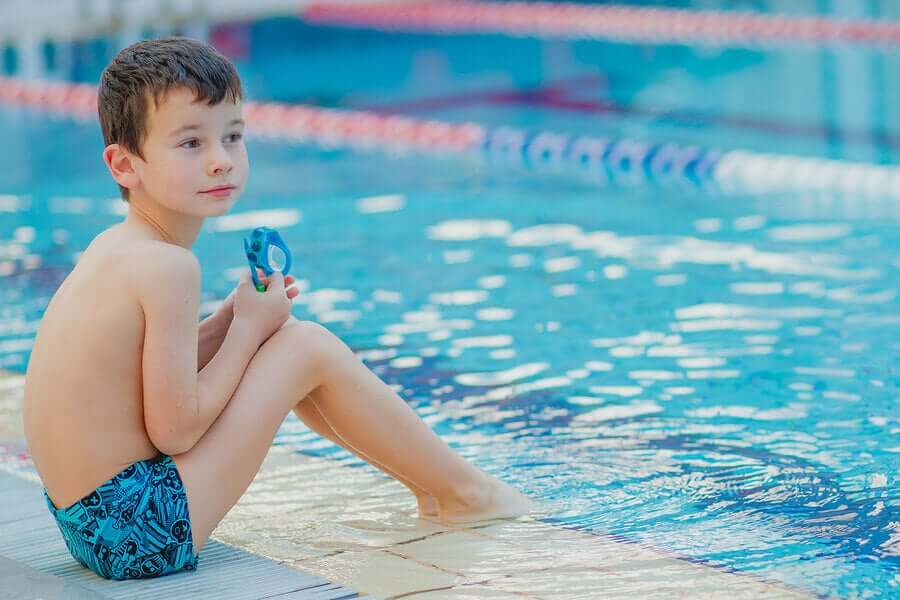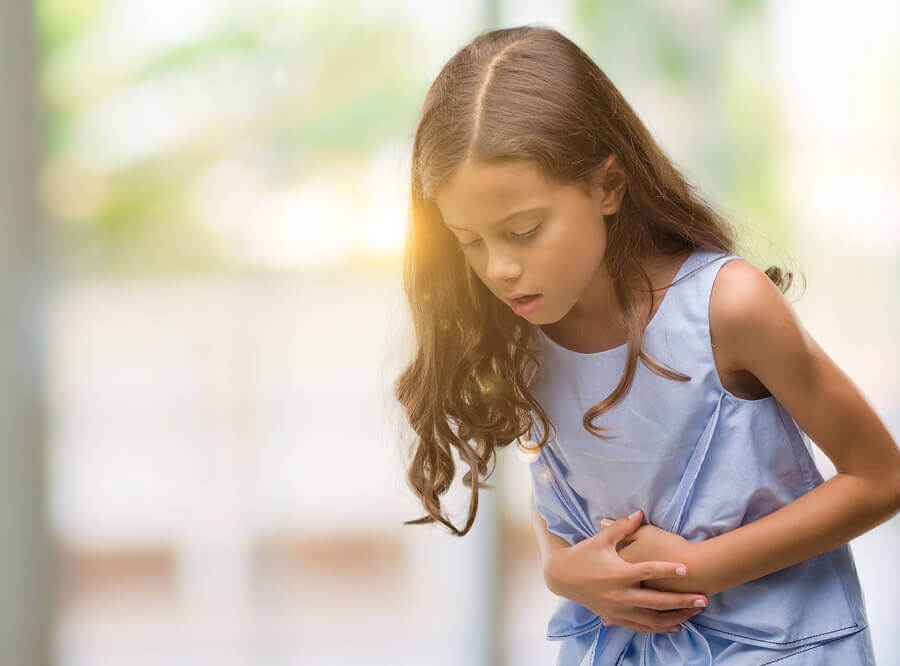Cold Shock Response in Children

Almost all of us have been told at one point or another that we shouldn’t swim in the pool or at the beach after eating. “You have to wait two hours for your food to digest.” That’s a persistent reminder that parents give children to keep them safe. But is it true? Or is the real problem cold shock response in children?
Simply said, you won’t drown if you go swimming after you eat. Your most significant danger when you go swimming after eating is probably a minor cramp.
Digestion continues its normal process and doesn’t cut back or stop when you enter the water. The real problem has to do with the change in temperature. The risk has nothing to do with digestion but with a cold shock response in children.
Hydrocution: what is it?
This refers to the loss of consciousness or death of a person after diving into the water. It doesn’t have to do with digesting your food after eating; it has to do with temperature changes.
When we introduce our head into the water, our heart rate decreases naturally because of the diving reflex. This reflex also causes the blood vessels in the skin to contract and increases blood flow to the brain.
The diving reflex is less notorious in adults. But in children, it’s quite potent, hence the danger.
It’s also necessary to consider differences in body and water temperatures, since the larger the difference between these temperatures, the stronger the diving reflex. This is because of the purpose of this reflex, which is to preserve body temperature by contracting blood vessels in the skin.
What’s the purpose of this reflex? To keep the body alive longer underwater by decreasing energy expenditure (thus extending the time needed to take another breath)
–Dr. Shora, El País–

What happens to our digestion when we swim?
Simply put, nothing. Our digestion is never interrupted, but it can favor a cold shock response in children. During the digestive process, the stomach needs to have large amounts of oxygen, which is extracted from the blood vessels.
To favor digestion, the blood vessels of the digestive system dilate. And as a consequence, the brain and other parts of the body receive less oxygen.
The danger of thermo-differential shock occurs more frequently with water temperatures below 81 °C.
–Actualización en medicina de familia (Advances in family medicine)–
Should I allow my child to swim after eating?
It’s not recommended. But remember that a cold shock response can occur in children even if they haven’t eaten. Nevertheless, it’s best to wait a reasonable amount of time before swimming, depending on the food they’ve consumed.
That means that if they’ve eaten fruits or a salad, they don’t have to wait too long. But they’ve just had an enormous feast, that’ll leave them very full for a few hours, so it’s best to wait longer.

How to avoid getting a cold shock response?
Remember that the process itself is due to the sharp temperature difference during immersion. So, the most important thing is not to dive completely and suddenly into the beach or pool. Instead, wet your body gradually, including the head, so that the body temperature will be similar to that of the temperature of the water.
This is especially important if the child has been playing sports or has been exposed to the sun. However, children must also wait a reasonable time to get into the water after the meal. The amount of time will vary depending on the type of food they’ve eaten and the amount they’ve eaten. But, generally speaking, two or three hours is enough.
The symptoms that can alert us to a cold shock response are nausea, vomiting, ringing in the ears, difficulty seeing, and loss of consciousness.
–Portalfarma–
If you follow these tips, you’ll help prevent cold shock response in children. Prevention and prudence are the real keys.
Almost all of us have been told at one point or another that we shouldn’t swim in the pool or at the beach after eating. “You have to wait two hours for your food to digest.” That’s a persistent reminder that parents give children to keep them safe. But is it true? Or is the real problem cold shock response in children?
Simply said, you won’t drown if you go swimming after you eat. Your most significant danger when you go swimming after eating is probably a minor cramp.
Digestion continues its normal process and doesn’t cut back or stop when you enter the water. The real problem has to do with the change in temperature. The risk has nothing to do with digestion but with a cold shock response in children.
Hydrocution: what is it?
This refers to the loss of consciousness or death of a person after diving into the water. It doesn’t have to do with digesting your food after eating; it has to do with temperature changes.
When we introduce our head into the water, our heart rate decreases naturally because of the diving reflex. This reflex also causes the blood vessels in the skin to contract and increases blood flow to the brain.
The diving reflex is less notorious in adults. But in children, it’s quite potent, hence the danger.
It’s also necessary to consider differences in body and water temperatures, since the larger the difference between these temperatures, the stronger the diving reflex. This is because of the purpose of this reflex, which is to preserve body temperature by contracting blood vessels in the skin.
What’s the purpose of this reflex? To keep the body alive longer underwater by decreasing energy expenditure (thus extending the time needed to take another breath)
–Dr. Shora, El País–

What happens to our digestion when we swim?
Simply put, nothing. Our digestion is never interrupted, but it can favor a cold shock response in children. During the digestive process, the stomach needs to have large amounts of oxygen, which is extracted from the blood vessels.
To favor digestion, the blood vessels of the digestive system dilate. And as a consequence, the brain and other parts of the body receive less oxygen.
The danger of thermo-differential shock occurs more frequently with water temperatures below 81 °C.
–Actualización en medicina de familia (Advances in family medicine)–
Should I allow my child to swim after eating?
It’s not recommended. But remember that a cold shock response can occur in children even if they haven’t eaten. Nevertheless, it’s best to wait a reasonable amount of time before swimming, depending on the food they’ve consumed.
That means that if they’ve eaten fruits or a salad, they don’t have to wait too long. But they’ve just had an enormous feast, that’ll leave them very full for a few hours, so it’s best to wait longer.

How to avoid getting a cold shock response?
Remember that the process itself is due to the sharp temperature difference during immersion. So, the most important thing is not to dive completely and suddenly into the beach or pool. Instead, wet your body gradually, including the head, so that the body temperature will be similar to that of the temperature of the water.
This is especially important if the child has been playing sports or has been exposed to the sun. However, children must also wait a reasonable time to get into the water after the meal. The amount of time will vary depending on the type of food they’ve eaten and the amount they’ve eaten. But, generally speaking, two or three hours is enough.
The symptoms that can alert us to a cold shock response are nausea, vomiting, ringing in the ears, difficulty seeing, and loss of consciousness.
–Portalfarma–
If you follow these tips, you’ll help prevent cold shock response in children. Prevention and prudence are the real keys.
All cited sources were thoroughly reviewed by our team to ensure their quality, reliability, currency, and validity. The bibliography of this article was considered reliable and of academic or scientific accuracy.
- Corte de digestión (AMF 2015) Aquellas pequeñas cosas. Amf-semfyc.com. 2018. http://amf-semfyc.com/web/article_ver.php?id=1445
- Portalfarma. Corte de digestión. https://www.portalfarma.com/Ciudadanos/saludpublica/consejosdesalud/Paginas/01cortedigestion.aspx
- Samper E. El corte de digestión: A fondo. La Doctora Shora. 2018. https://blogs.elpais.com/la-doctora-shora/2011/08/el-corte-de-digestion-a-fondo.html
This text is provided for informational purposes only and does not replace consultation with a professional. If in doubt, consult your specialist.








